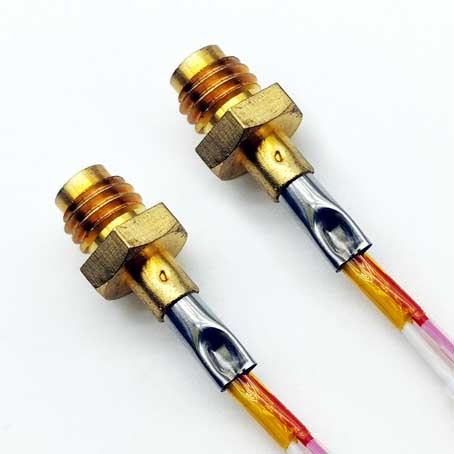Categorias de Produtos
- fusível térmico 32
- fusíveis de montagem em superfície 12
- termistor 36
- Suporte de fusível para montagem em PCB 27
- Chicote de fiação 6
- Porta-fusíveis de lâmina 17
- termostato 50
- Fusível elétrico 24
- Sensor de temperatura automotiva 7
- Disjuntor térmico 22
- Porta-caixa de fusíveis 36
- Sensor de temperatura 75
- Interruptor térmico 68
- Fusível do carro 20
- Fusíveis aparafusados 8
Etiquetas de produto
Sensor de temperatura termistor para aparelhos elétricos
Como todos sabem, os Pequenos eletrodomésticos , como um utensílio de cozinha doméstico popular, não só tem a função de aquecimento, mas também tem muitas funções automáticas. Por exemplo, preservação automática de calor, água fervente automática, cozimento automático de arroz, cozimento automático de sopa e outras funções. A realização de todas estas funções automáticas exige que os pequenos eletrodomésticos sejam capazes de medir e controlar com precisão a temperatura. Os pequenos aparelhos existentes usam principalmente um sensor de temperatura para medição de temperatura. Como:
Como todos sabem, os Pequenos eletrodomésticos , como um utensílio de cozinha doméstico popular, não só tem a função de aquecimento, mas também tem muitas funções automáticas. Por exemplo, preservação automática de calor, água fervente automática, cozimento automático de arroz, cozimento automático de sopa e outras funções. A realização de todas estas funções automáticas exige que os pequenos eletrodomésticos sejam capazes de medir e controlar com precisão a temperatura. Os pequenos aparelhos existentes usam principalmente um sensor de temperatura para medição de temperatura. Como:
Como mostrado na FIG.. 1, é um diagrama estrutural esquemático de um sensor de temperatura convencional de pequenos eletrodomésticos com uma sonda 2 para entrar em contato com o painel de Pequenos Eletrodomésticos 1. A sonda 2 é um dispositivo sensível ao calor, como um resistor térmico. Um assento de borracha 3 feito de material isolante térmico fixa a sonda 2 no topo. Então, a base de borracha 3 está instalado no centro do painel Pequenos eletrodomésticos 1, para que a sonda 2 está totalmente em contato com o painel de Pequenos Eletrodomésticos 1, e o líder 4 também é conduzido para fora da sonda 2. O sinal de temperatura é transmitido ao microprocessador dos pequenos aparelhos pelo fio condutor 4 para processamento adicional. Com este sensor de temperatura de pequenos eletrodomésticos, já que a área da sonda 2 é limitado, a área de contato com o painel de Pequenos Eletrodomésticos 1 também é limitado. Além disso, já que o formato da parte de contato da placa do cooktop de indução 1 e a sonda 2 pode ser desigual, não é possível garantir o contato completo entre os dois. Além disso, como a base de borracha 3 idades durante o uso, a possibilidade de contato incompleto aumenta, o que faz com que a temperatura medida pela sonda 2 ser inconsistente com a temperatura real do painel de pequenos eletrodomésticos 1, afetando assim o uso dos pequenos eletrodomésticos.
O sensor de temperatura nos pequenos eletrodomésticos é na verdade um termistor semicondutor com coeficiente de temperatura negativo. O valor da resistência diminuirá à medida que a própria temperatura aumenta, e a temperatura aumentará, e a tensão através da resistência mudará através da mudança na resistência. Se não estiver conectado, os pequenos eletrodomésticos causarão um alarme e serão perigosos.
Geralmente, dois tipos de resistores com as mesmas especificações são usados dentro dos pequenos eletrodomésticos: Um detecta a temperatura da superfície do forno, Um detecta a temperatura operacional do IBGT. Quando você abre a tampa superior dos pequenos eletrodomésticos, há um elemento circular no centro da base, qual é o sensor de temperatura para pequenos eletrodomésticos.
O controle de temperatura dos pequenos eletrodomésticos é transmitido ao chip IC e convertido em um valor de temperatura de acordo com o valor de resistência do termistor. A fim de atender aos diferentes métodos de aquecimento de temperatura. O outro sensor de temperatura é fixado na placa de alumínio do dissipador de calor ou aperta o tubo de alimentação. Claro, alguns sensores de temperatura são instalados na placa de circuito próximo à placa de alumínio dissipadora de calor, que parece igual ao meio sob o painel.
Métodos comuns de solução de problemas de pequenos eletrodomésticos:
1. O ventilador não gira: Verifique a fonte de alimentação do ventilador e verifique se a tensão na fonte de alimentação chaveada de 18V está normal.
2. O ventilador faz barulho ou gira: Verifique se a posição de soldagem do cristal da CPU está correta, e se as almofadas estão dessoldadas.
3. A potência não é ajustável: Verifique se a CPU funciona normalmente (medir a tensão dos pinos relevantes), e veja se o potenciômetro (RV) na placa-mãe que regula a corrente é normal.
4. Comece sem aquecimento: Verifique se o termistor sensível à temperatura está em curto-circuito, verifique se o indutor L3 está soldado ou danificado, e verifique se vários resistores de alta potência na placa-mãe estão danificados.

Sonda de chip termistor SEMITEC

Sonda e cabo do sensor termistor Shibaura personalizado

Sondas e cabos do sensor termistor TDK

Sondas e cabos de sensores NTC para eletrodomésticos
Contate-nos
Aguardando seu e-mail, responderemos dentro de 12 horas com informações valiosas que você precisava.
 English
English Afrikaans
Afrikaans العربية
العربية বাংলা
বাংলা bosanski jezik
bosanski jezik Български
Български Català
Català 粤语
粤语 中文(简体)
中文(简体) 中文(漢字)
中文(漢字) Hrvatski
Hrvatski Čeština
Čeština Nederlands
Nederlands Eesti keel
Eesti keel Suomi
Suomi Français
Français Deutsch
Deutsch Ελληνικά
Ελληνικά हिन्दी; हिंदी
हिन्दी; हिंदी Magyar
Magyar Bahasa Indonesia
Bahasa Indonesia Italiano
Italiano 日本語
日本語 한국어
한국어 Latviešu valoda
Latviešu valoda Lietuvių kalba
Lietuvių kalba македонски јазик
македонски јазик Bahasa Melayu
Bahasa Melayu Norsk
Norsk پارسی
پارسی Polski
Polski Português
Português Română
Română Русский
Русский Cрпски језик
Cрпски језик Slovenčina
Slovenčina Slovenščina
Slovenščina Español
Español Svenska
Svenska ภาษาไทย
ภาษาไทย Türkçe
Türkçe Українська
Українська اردو
اردو Tiếng Việt
Tiếng Việt

